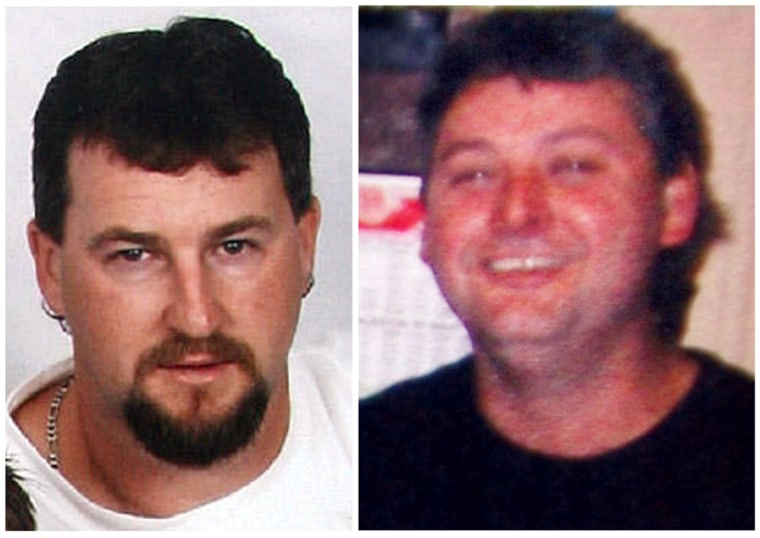Bells pealed and sirens wailed as this tiny mining town erupted in jubilation Tuesday after two miners were rescued from the kennel-sized cage where they had been trapped more than a half mile underground for two weeks.
But the joy quickly turned to grief as mourners gathered to bury a miner who died in the same rock collapse that trapped his co-workers.
“There’s not many things in life that take us through so many emotions at the same time,” said Graham Mulligan, spokesman for a Christian motorcycle club which escorted Larry Knight’s coffin from the church to a nearby cemetery.
“This whole ordeal has taken us from horror to shock, grief, sadness, joy and happiness and then back to sadness again.”
'The Great Escape'
Brant Webb, 37, and Todd Russell, 34, punched the air as they walked out of the Beaconsfield Gold Mine before dawn Tuesday, freed by rescue crews drilling round-the-clock. Hundreds of well-wishers gathered at the mine gates erupted in cheers.
The miners hugged family and friends before climbing into two ambulances, laughing and joking. Before going, they removed their identity tags from the wall outside the elevator — a standard safety measure when miners finish a shift.
The men also handed out small cards that read: “The Great Escape. To all who have helped and supported us and our families, we cannot wait to shake your hand and (buy) you a Sustagen,” referring to a nutrition drink the pair sipped during their ordeal.

As news of the rescue spread, a fire engine drove with its siren blaring through Beaconsfield, located in the southern state of Tasmania. A church bell not used since the end of World War II rang out in celebration.
Webb and Russell were then driven through Beaconsfield in two ambulances, their back doors open so they could wave to townsfolk, and underwent tests at a hospital. The families said neither they nor the miners planned to speak to the media Tuesday.
One of the rescuers, who identified himself only as Peter, said many miners celebrated with free beer at a local bar before turning to the more somber business of the day — burying their colleague Knight.
Russell limped into the service, which was attended by hundreds of Beaconsfield residents, but otherwise looked fit and healthy, the beard he had grown during his underground ordeal trimmed to a goatee. It was not immediately clear if Webb also attended.
Knight’s family had delayed the service hoping the trapped miners would be able to attend.
Webb and Russell were buried after a small earthquake April 25 trapped the safety cage they were working in under tons of rock.
Round-the-clock digging
Teams of miners bored through more than 45 feet of rock over the past week with a giant drilling machine to reach the men. But cutting the final sections of the escape tunnel was slow and difficult, as the men used hand tools to avoid causing a cave-in.
For 300 hours, the two miners had huddled in the 4-foot-tall cage until rescuers broke through the last crust of rock, five times harder than concrete. Rescuers could only work one at a time on their backs in the cramped tunnel, wielding hand-held pneumatic drills, diamond-tipped chain saws and jackhammers as heavy as 88 pounds.
Rescuer Glen Burns said miners finally broke through using chisels to open up a crack wide enough to see through. “And we just made eye contact, that was first, and then made that bit bigger and then shook their hands,” he said.
Television networks all carried live coverage of the climax of the men’s rescue and The Sydney Morning Herald newspaper published a special midday edition with a picture of the two miners emerging from the mine under a headline declaring: “Free at last.”
Seventeen men were working the night shift when the quake sent tremors through the century-old mine. Fourteen men made it safely to the surface, but Webb, Russell and Knight had been working deep in the belly of the mine repairing a tunnel.
Webb and Russell survived because a huge slab of rock landed on their safety cage, forming a roof that kept them from being crushed. For five days they lived on a single cereal bar and water they licked from rocks, until rescue crews with thermal heat sensors detected them April 30.
iPods and sandwiches
The rescue team forced a narrow pipe through a hole drilled through the rock and pushed through supplies including water, vitamins and fresh clothing. Comforts such as iPods, an inflatable mattress, egg and chicken sandwiches and even ice pops followed.
Throughout the rescue, the good spirits of the miners, both married with three children, amazed those struggling to reach them.
One man asked for a newspaper so he could start scanning the classifieds for another job. Another said that once freed, he wanted the ambulance to stop at McDonald’s on the way to the hospital.
The tense drama recalled the rescue in 2002 of nine miners from the Quecreek Mine in Pennsylvania after being trapped for 77 hours underground — less than a quarter as long as the Australian miners spent awaiting rescue.
Australia has a strong mine safety record compared with many other countries. After the deaths of 16 West Virginia coal miners earlier this year, U.S. labor leaders and experts held up Australia as a possible role model.